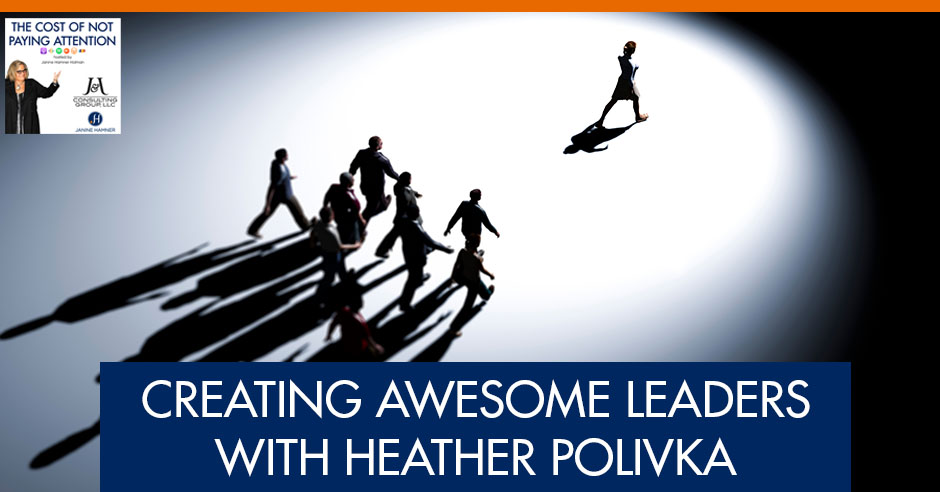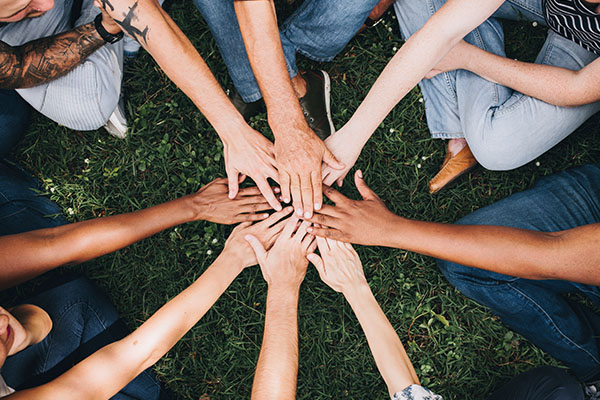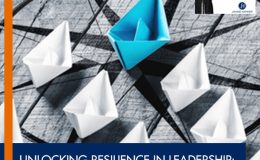
Our skill in decision-making is the bridge between emotional intelligence and unconscious bias. This connection is one factor in defining leaders. In this episode, Heather Polivka, a trusted business advisor and founder of the startup Awesome People Leaders, shares that when we don’t understand our brain and others’ brains, we cannot lead human beings. Heather explains that many people can be a leader, but there is a distinction of being an awesome leader. Tune in to learn more.
GUEST: Heather Polivka | LinkedIn | Visit their Website: Awesome People Leaders
HOST: Janine Hamner Holman | Janine@JandJCG.com | LinkedIn, Facebook, Instagram, and Twitter |
—
Listen to the podcast here
Creating Awesome Leaders with Heather Polivka
What am I paying attention to in this episode is the connection between emotional intelligence and unconscious bias. I get to do work in both of these arenas. I’m an emotional intelligence practitioner and do a lot around diversity, equity, inclusion and belonging. Unconscious bias is a key piece of that. Until recently, I had never understood the opportunity and the way that these two things can play off of each other. Let me give you an example. I’ve been doing work in both of these arenas for years. I didn’t get the connection until recently, which is both awesome and mind-blowing.
Here’s what I suddenly realized. One of the pillars of emotional intelligence is around decision-making. Part of the evolution that emotional intelligence went through from when it was originally created as a self-discovery and self-help tool to how it’s often used now in the world of work is two additional pillars around decision-making and stress management were added.
One of the skills around decision-making is reality testing. We check our idea about something against reality. This is what I think we should always do when we’re making a decision. How we check ourselves as compared to reality is key to decision-making. If we are low in this arena of emotional intelligence as opposed to our IQ, our EQ, Emotional Quotient, is something that can be developed over time. It’s like a muscle. We develop our muscles and emotional intelligence or we don’t. Reality testing is a muscle that can be developed. If we haven’t done much exercising with that muscle or if we have a low emotional quotient in that arena, what it means is that our decisions are going to be driven by our unconscious biases. We’re not going to remember to try to find other perspectives. We’re not going to even realize that we’re operating out of biases we have in our unconscious. I’ve talked about this before. Unconscious bias is not something we can get rid of. It’s hardwired into our brains. It’s how our brain sorts information.
The key with all the work that’s being done around unconscious bias is to get it out of our unconscious into our consciousness so that then we can make a decision about it. If it’s just in our unconsciousness and we don’t know that’s how we’re making decisions, then we don’t know that we’re supposed to be reality testing against the way we see the world. Isn’t that fascinating? On that note, I’d like to introduce our guest for this episode.
Heather Polivka and I met when we were both on stage at the California HR convention. When I heard Heather talking, I thought, “This is somebody who sees the world in a very similar way that I do.”
I’m thrilled that she is here with us. Heather is the Founder and CEO of two different companies that both, in their own way, seek to create a new norm of work, where people thrive, where teams excel, and company cultures are enlivened.
For twelve years, she served as a Fortune 6 organization’s critical link between marketing and human resources to help them grow four times over, transform their culture, repair their reputation as a place to work, integrate twenty-plus acquired businesses, and localize their presence in culturally relevant ways.
Today we’re going to focus on her startup organization Awesome People Leaders and the impact of people leadership on the work experience. Welcome to the show, Heather!
We can't lead human beings if we don't understand how our brains are working and other people's brains are working. It's vital in leadership. Share on XThank you. I’m so excited to be here. I felt the same way, Janine. It was my mind melting what was going on. We both come at it from different angles, which I love. I appreciate where you started this off because one of the things that the Awesome People Leaders program starts with is brain science. Most people think, “That’s not what I would have thought it should be.”
We can’t lead human beings if we don’t understand how our own brains and other people’s brains are working. It’s so vital in leadership. It’s exactly what you’re talking about. When we’re making decisions, part of that decision-making is understanding how our brains work. A big part of that understanding is seeing that our brains are working to help us a ton. They’re working at the speed of light. They’re trying to keep us safe. Sometimes they try to help us out and take shortcuts. The unconscious bias shortcuts are not so helpful.
One of the key practices is first understanding, and then slowing our thinking down just enough, like a nanosecond. Even that check for reality, there’s a form of unconscious bias. Janine, you already know this but, for our audience, I’d like to point out the form of unconscious bias which is when you seek out resources that will validate your point of view. We even need to slow down enough that when we’re checking reality, are we checking a shared reality or just the reality we want to live inside of?
Are we checking in our own bubble or are we getting outside of our bubble to check reality versus just listening to the people who we usually listen to, or the perspectives that validate what we want to hear? If you’ve got a low EQ around reality testing, what we’re often doing is we are seeing the world as we would like it to be and not as it is. At this moment in time, unfortunately, so many of the voices that people are listening to are people who reaffirm their own thinking.
Find ways to get outside of our own thought group, which isn’t necessarily saying if you’re a political lefty, you’re going to go watch Fox News. Nor am I saying that if you skew right, go listen to MSNBC. You can get on the interwebs, as a friend of mine calls it, and you can check. You can pick up a book, go to the library, or talk to people who are different from you and have a different lived experience than you. Maybe check it out by saying, “Here’s what I’m thinking about (fill in the blank). What do you think about that?”
I’ve got a great app for that. It curates the same story. Let’s say the weather where I’m at now. It curates it from various news sources that run the spectrum. You can see how the same story is being represented right, middle, left, and internationally versus domestic. In a snapshot, you can get a sense of how it’s being represented and then apply critical thinking to come to your own conclusions.
That’s amazing. What is that resource?

Awesome Leaders: Create a sense of belonging and inclusion.
I was looking for that. I get the alerts and just read the alerts, so I don’t know off the top of my head. I’m lazy that way.
As we say in Massachusetts, which is where I grew up, “Aren’t we all?” We are all looking for shortcuts. We are all looking for fast ways to do things. You and I have talked about this. I am a woman who has struggled with my weight my whole life. If there were a pill that came out tomorrow that would magically deal with this situation for me, I would take it.
I’m working with a client who originally came to me. They had heard me talk at that same conference in Anaheim. They said, “We need to do something around conscious leadership. We would love to hire you and work with you. We love the way that you talk and present things.” We started having conversations and the director of HR said, “My boss thinks that we can get all this handled in half a day with $2,000.”
I started laughing and said, “That’s adorable your boss thinks that.” We all want a solution that’s going to solve the problem quickly and then get back to work or whatever it is that we are doing. The reality is that for them and for any organization that wants to take on something meaningful, it’s going to take resources.
That’s true.
I looked up the app I was speaking of. It’s Grounds News. You pull up a story and it will show you a spectrum of how it’s being represented right, left and center. It’s a great way for all of us to check ourselves and, at the very least, seek to understand different points of view even if you go, “There’s no way I could ever agree on the same outcome or decision.” It seeks to understand where someone is coming from and what might have led them to that outcome or decision. It would empower all of us.
I love that resource exists. Part of what I love about this is when we can understand somebody else’s position, which is empathy, and when we can feel with somebody else, it’s much harder to cast them as the devil, as unthinking, as less than human, and all of the ways in which we put people in boxes as the other. I can’t get over what a brilliant idea this is. Being able to see the same story and being presented from these different perspectives helps us understand how it is that somebody who is not like me could have such different thinking about something. You see the news and information that they are getting being filtered various ways.
Have you seen Steven Spielberg’s remake of West Side Story? If you haven’t seen it, I highly recommend it. It’s beautiful. Aesthetically, it’s amazing. One of the things that I enjoyed about it is it’s exactly the same story but told through a modern lens, even though it’s still happening in the past. One of the things that was so revealing to me is how folks, whether they were the Jets or the Sharks, had their reality shaped by what was happening in their environment.
We need to check ourselves and seek to understand different points of view. It would empower us. Share on XYou could understand their perspective. You could understand that nobody is bad. Everybody is misbehaving, but nobody is coming at it from a place of trying to be evil or do the wrong thing. They’re all products of their environment. When we can see people like that, understand the things that have molded them that are connecting in their brains, and understand what’s happening in their brain and what that is being formed by, it helps us make a much more nuanced assessment and allows us to connect with them as a human.
I think of this as how this goes in the workplace. I am an adamant believer that no one wants to show up to work and fail althought there might be that 1 in 100 exception.
Agreed. 99 out of 100 people do not want to show up to work and fail. We want to show up to work and be effective and awesome. I’m going to use that to get us right into Awesome People Leaders.
I think about how this shows up in leaders. We need leaders. It can be easy as a leader if I have a particular style or see things a certain way. Maybe I’m a driver and a fast decision-maker. I’ve got high expectations. I don’t understand the person on my team who always wants to chit-chat. We need to get to work. We need to get things done. I may devalue their contribution because they’re not like me. They don’t function and go about work the same way I go about work.
We think that the way we do things is always the best way. I may devalue that person for be chatty and not see that this is someone who connects with people. This is someone who builds relatedness. Nothing ever got done, sold, built or made without relatedness. You might have an idea, but you need other people to buy into that idea. Part of them buying into that idea is buying into you, so there has to be relatedness.
This is where it comes into the workplace. I think it can be easy for us to see outside of work. In the political landscape that it’s more obvious how “They’re not like me” shows up versus in the workplace. It can be quite nefarious because it’s so subtle and under the radar. As a leader, I may not be aware of brain science or maybe I haven’t done my own work to pause and reflect on my own thinking and the shortcuts my brain is trying to take. Why I might instantly connect to someone is because they are like me.
I’ll use this example. The last thing I need in my marriage is more of me. We need those counterbalances. Many studies have shown that when we have more diverse perspectives, experiences, and skills at the table, we produce better outcomes that drive better productivity, innovation, and profitability. The danger is that we don’t slow down our thinking. We don’t create workplaces that not only allow, but more importantly encourage almost a hunger, for a variety of perspectives, skills and strengths. We create places where people keep leaving, and we wonder why.

Awesome Leaders: As leaders, there is an emotional cost when we have to make tough calls.
One in four new hires in 2021 left their jobs. They’re new hires. A company spent a lot of money to recruit, onboard, and train them. The person changed their lives to go and onboard with the new company, their computer, their things or maybe they commuted, and then they said, “I’m out of here.” Neither party wins in that instance. There were some expectations either that were set by the company or were expected on the part of the talent, or probably both.
The reality is often somewhere in the middle.
Expectations weren’t met to such an extent that it was easier to part ways than to try to work through it. It’s those nefarious ways that this shows up in our places of work in terms of the fast pace. I get it because I’ve been a leader in a large global organization. You’re doing probably more than one job. That one job was never a 40-hour-a-week job. You have this pressure in the sense of needing to move fast.
I get that reality and yet it’s in those moments that you have either created a sense of belonging, inclusion, and having people feel known, seen and valued or you can destroy all of that. That’s where both emotional intelligence and unconscious bias are about the discipline of slowing down our thinking. By slowing down, I’m not saying, “We must take a 30-minute coffee break.” It’s slowing down enough that we’re running our brains, and not letting our brain run us.
I am that driven type-A manager like, “Get things done. Get them done fast. Get them done my way,” and I haven’t done the work, and then I have this employee who wants to chit chat and connect. That’s how you get the best from them. It’s by connecting and I don’t get that. I keep trying to force, encourage or drive them. I’m going to burn them out and they’re going to leave. I’m also creating a self-fulfilling prophecy that they are not awesome.
In the world of brain science, I am the type-A manager, and my brain expects you to need my time and my attention. I think that’s bullshit so I don’t give it to you. You then underperform because you don’t feel connected to me. My brain then says, “See? Heather is a problem.” I then asked you for something else. You want to connect and I don’t get it, and so it goes. It keeps going that way. I am actively participating in having you fail, but I don’t see it because I haven’t understood any of this. Folks out there reading this are like, “This is me. This is my team. This is my organization. I would love some resources around this.” Tell me about Awesome People Leaders and how that can help.
What makes Awesome People Leaders distinct are a couple of things. First of all, we use all micro lessons. All of our lessons and modules are 10 to 15 minutes max. It’s great with the fast pace of business but more importantly, it fits with how our brains function.
If an organization is going to future-proof itself for the workforce, this people-centric leadership style will have them thrive leading into the future. Share on XAs adults, our brains can only consume so much information without a break. If I’m intensely working on something, I might need to take a break, pick up my phone, play a game, and then come back because our brains need a break. I love that you’ve created these as little bite-sized pieces, both because it’s easy in the fast-paced world of work. More importantly, it’s how we consume information the best and how it sticks. You’re so smart.
I had it formatted because there are different kinds of learners. We have a video and a handout. Even the handout is more about how people consume content these days. It’s more scannable. It’s highly visual. It’s not like a whitepaper dissertation. That’s another thing that makes it different. We combine this. This is all available online. People can guide themselves. There is an order, but we don’t force the order because we want people to go to the module they need when they need it. This online portion is then married with this high-touch support via a private online community and monthly calls by experienced business leaders who also understand HR best practices and brain science. This is in the real world.
We talk about things like no matter how much it’s validated, it’s terrible when you need to let someone go. I have shared this with the participants. I generally get a horrible night’s sleep the night before. I can’t eat in the morning. In fact, I can’t eat until after it has been done. I still feel nauseous. I just want to end my day because I’m so emotionally burned out. That’s even someone who, by all accounts, was 100% validated in needing to let them go. There is an emotional cost to us as leaders when we have to make those tough calls, but we don’t talk about that with leaders.
It’s normal and okay.
Awesome People Leader participants get answers within one business day. They have live resources. Oftentimes, people don’t feel comfortable going to their own boss because they don’t want to look stupid, or maybe their own boss wasn’t trained, or is busy, or for many other reasons. We married this online course with this high-touch support. The micro lessons are what make us different.
The last thing I’ll point out is our program is for a full year. We do a full business cycle. Think about your business cycle. There are times when you’re doing reviews and budgeting. There are things with which you’ll interact as a leader. How you lead in your first three months of being a people leader and what you can absorb and hear is very different than in months 9 through 12. We want to be there to give them a strong foundation before we pushed them out of the nest.
I love that you’re taking this deliberative approach. If somebody is an individual practitioner or they’re with a Fortune 10 company and the whole gamut, are there ways for individual practitioners to plug into Awesome People Leaders? What’s the way for a big organization to plug in?

Awesome Leaders: The problem is most employees have very little attachment to learning management systems.
We won’t say no to a big organization, but we designed this for businesses with 1,000 employees or less. Here’s why. I’m going to get myself in trouble here. Large organizations have learning management systems. They’re attached to learning management systems. The problem is most employees have little attachment to learning management systems. There’s a big fight to get people to go into the learning management system because it’s not in the flow of their work; it’s a separate system. We are intentionally not, nor is it ever on our roadmap to be, set up to work within a learning management system.
There are two reasons for that. One is we would have to dumb down the experience too much to work effectively inside of the learning management system. I’m more committed to providing value than I am to that. Secondly, I want it to be in the flow of work. We do our notifications via email, text, and Teams messages. We are working on how we can embed this in Teams, Slack, and more in the flow of work because that’s when and where we need it. Not a separate system somewhere. We designed this to be a solution for individuals and companies up to 1,000, but we won’t say no if you want to join and are larger than that – as long as it works for you.
You’re not going to figure out how to be part of the Monster Energy learning system for their people.
Having been inside, I know these systems don’t work. They don’t work for the learner. They work for the company to be able to track and provide great reports on what they think the ROI is.
Or to track if people are in or out of compliance.
We don't have to put up with toxic workplaces. Share on XMost learning systems are also primarily for desktops. The other thing with our program is that it can be used on the device of your choice. That is because we want to meet people where they’re at. When they have time, they got a few minutes to sit down and go, “I’m at the coffee shop. I’m in a space where my brain can process ten minutes of content. I’m going to do it on my mobile phone right here.” What I love is that we are reaching out to companies directly. We’ve had quite a few companies where it was an individual within their company that signed up. You go to AwesomePeopleLeaders.com, and you can sign yourself up.
In fact, I have a company now that has expanded because their manager kept going, “Where are you getting these tools? Where are you getting these awesome status documents? You’re bringing me a development plan?” It’s all these things that their manager got so intrigued and the company wanted to have a call with us because they see immediate impact and tools. We’re all about it being practical and actionable. People see the value in that right away. We’ve had a number of companies that have come to us because an individual signed up.
It’s the best business model. When you have individual practitioners inside of your company, frontline people or individual contributors who have read this episode about this tool, they’re thinking, “That sounds great. I’m going to check it out. If it doesn’t cost an arm, and a leg and a baby calf, I’m in.” I then start showing up differently. I’ve got new tools and resources. My boss gets curious, then her boss gets curious, and their manager gets curious. On and on, it has an opportunity to go.
Here’s what I loved about the boss of this person who signed themselves up when we got on and did a Zoom call. This is validated by studies that they had been leading people for ten years. They could count on one hand the number of hours of people leadership training that they had. They were like, “When I saw some of these tools, I have to admit I was a little jealous. I wish I had these tools.” I loved that vulnerability because we need more of that in leadership. For too long, we’ve thought leadership is this one model of command and control, top-down, and valuing technical skills and productivity. What’s called for now in our world is a people-centric model and an emotionally intelligent model.
We keep talking about burnout, and we should talk about burnout, but we were not spending enough time talking about the skills we all need to learn as individuals and even more importantly, as leaders. The emotionally intelligent people-centric skills that will have us not burn people out or say, “This doesn’t work and here’s why,” to our management. So for instance, someone could be empowered to say, “I can’t do three jobs! I’m only one person.” It costs us money in the long run because when we lose that person, we’re going to have to hire, retain, train, and “all the things.”
It’s interesting because Awesome People Leaders is participating in a pitch competition for a startup. One of the judges is wondering, “How long is this whole trend of people moving jobs going to go on?” This is where I was so glad you and I met, Janine, because one of the stats I remembered from your presentation, by which I was so blown over by, was that Gen Z and Millennials will make up 75% of the workforce in 2025.
I sent this back to the judge. I said, “Here’s the thing. Millennials and Gen Z have higher expectations for their companies and leaders. They have a lower tolerance for toxic work environments and for leaders who don’t know what the heck they’re doing, and who aren’t bringing that people-centric leadership style. While the trend of turnover will slow, if an organization is going to future-proof itself for the workforce, this people-centric leadership style will have them thrive leading into the future.”

Awesome Leaders: There’s a big fight to get people into the learning management system. APL is not in the flow of their work, it’s a separate system.
Here’s one of the things that is so interesting about the shifts that are happening in the world of work largely driven by the younger generations who are already the majority and will just continue to increase. If we haven’t gotten on board with the things that those generations care about, yesterday is the time but if you didn’t do it then, the time is now. They are our children. I’m 57. The oldest Millennials are now 41. Isn’t that amazing? The mid-Millennials are my children. They’re in their 30s. They grew up watching us.
I grew up watching my dad. My dad was at the same company for almost his entire career. Something catastrophic happened toward the end of his career and he left that company…and he was still at the same company for almost 30 years. That’s what I thought was normal. The reality is, I spent my whole career wondering, until I started my own business “Is what I will do until I retire?” And I still wonder it now! Is this what I dill do until I retire? Who knows? Maybe I will or maybe I won’t.
I was always looking for that company that I’m going to spend my whole career with. I never found it. I was with some places for close to a decade. Our kids saw that with us. There were some places I was in for a year. In general, I was in most places for 5 or 6 years, a few for longer. So now, watching us, our kid’s assumptions are people don’t stay in the same place forever. Marry that with a low tolerance for bullshit in the workplace, then our expectations of them should not be that.
I remember when I was hiring people back in previous roles. I wouldn’t hire somebody who had job jumped and had been at lots of places for 18 months or 2 years. That is typical now with this generation. Occasionally, they find someplace that they like, and they’re there for 3, 4 or 5 years. And, of course, in any generation, there are many exceptions to the irule. But, In general, that’s the way that they think about work.
Our opportunity to get them retained is all about connection. It’s all about them feeling like they belong, they matter, and they have a voice. That is the only thing that’s going to keep them around.
They grew up also seeing the generation ahead of them. We work hard because that’s what we thought. They work hard, move the ladder, and then have the rug pulled out from under them with layoffs. They’re like, “When push comes to shove, there is no loyalty here.” They’ve watched my parents, aunties, uncles, and others give up a lot for that company and not have it paid off in return. There’s also a certain amount of, “I’m not going to expect loyalty. Neither do companies get to expect loyalty from me.”
That’s where being known, seen and heard are so important. I think a lot of Gen X is a bit jealous like, “I wish I would have had that lesson 10 or 20 years earlier. Thank you, Gen Z and Millennials, for being the tipping point that said we don’t have to put up with toxic workplaces.” We think about what we’ve all been through and are continuing to go through with a global pandemic. There are layers and layers upon layers of unprocessed grief and trauma, etc., which is also contributing to burnout. We lack most people leaders having foundational people skills to help lead through that. That’s the other reason why there’s a lot of struggle. It’s because the solution is not pushed harder.
Given how we’re wired, grew up, our parents or whatever, many of us think we should be able to just power through it with everything that we have been dealing with collectively over the last several years, from the global pandemic, the murder of George Floyd, the reckoning around race and identity, the schisms that have happened between the left and the right, the vitriol around it, the dehumanization, and the isolation because of the pandemic. I have a cold, and my first thought is, “Do I have COVID?” That level of constant fear, concern and worry takes a huge toll on our bodies because of how our brains are wired. It’s all backed by brain science.
Be gentle with yourself, slow down, even just a nanosecond, and remember that everyone else is just doing the best they can. Share on XOur brains hate uncertainty, and we are swimming in a world of uncertainty. I’m getting to work with an organization that has been through an enormous amount of organizational change. Their organization moved. They hired a new CEO, and the CEO changed the organizational structure in some fundamental ways. I was talking with a vice president who himself is a type-A person. I told him, “Burnout is a national epidemic now.” There are a number of good books that have come out about burnout because it is a national epidemic. I said, “If you think about yourself and that concept of burnout, where would you put yourself on the risk scale? 10 being, “I’m in trouble,’ and 1 being, “I’m totally fine.” He replied, “I’m probably an 11.” I told him, “It’s a great realization and self-understanding. Let’s have a conversation about what we get to do about that now that you’ve realized that and how we get to recover you.”
There has been so much about resilience and equating it with grit and turning through it. You and I know this is a bullshit strategy. Grit is not going to get us through this recovery, which is a key component of resilience. My mentor, Adam Markel, is a leading authority in the world of resilience. A lot of what he talks about is recovery. How do we begin to recover you to yourself so that you can continue to be a leader in this organization and the movement? He’s part of the Native American World. He’s from a Native American tribe and doing a lot in that world.
The idea is, “You’re up to big stuff. How do we help ensure your longevity so that you don’t burn out?” I love that it’s part of your goal with Awesome People Leaders. It’s to help people understand themselves and get these skills. Most leaders have never been trained at all. Many leaders are drastically undertrained. This is a place where people can go to get this training and support in super bite-sized pieces, which is how we learn as adults. I love what you’re up to.
Thank you. I love it too. It’s not a path I expected to go down. It was one that my clients kept requesting. Every time I see that light bulb go on with the People Leader. I know they’re going back and their impact is on their team, boss, and peers. That fuels me, brings me joy, and makes me excited and hungry for that next light bulb.
As we start moving towards wrapping up, I want to give you an opportunity. If there was something that you wanted to share about that we haven’t had a chance to touch on yet or if not, if we’ve done such an amazing job, where would you love to leave people? I want to give you an opportunity to share that.
We’ve talked about Awesome People Leaders, and people can learn more on the website. I would love for them to reach out to me because there’s nothing I love talking about more.
How can people reach out to you?

Awesome Leaders: Being known and seen and heard is so important.
You can go to AwesomePeopleLeaders.com. There’s a button up in the corner that you can set up a time with me and demo it. With the demo, we’ll have a chance to have a chat. You can connect with me on LinkedIn. Those are the two best ways to connect with me. Here’s where I would want to leave people. First of all, be gentle with yourself. Slow down, even just a nanosecond, and remember that everyone else is doing the best they can.
You and everyone else we’re all doing the best that we can. Nobody has the plan to fail. It’s how we can continue to lift everybody else up.
Heather, thank you so much for being with us here, for sharing your wisdom and brilliance, and for all that you do to lift me up and all of the other people in your life, both through your organizations as well as Awesome People Leaders.
Thank you for seeing this gap and for realizing that this was something that needed to be done, stepping into that, and sharing your brilliance. It takes a long time to develop all of the content that you’ve created. I want to appreciate and acknowledge you for bringing this to fruition and into the world. It is so needed.
Thank you. It’s been my pleasure.
Remember, great leaders make great teams. Until the next episode.
Important Links
- Awesome People Leaders
- Grounds News
- Adam Markel
- LinkedIn – Heather Polivka
About Heather Polivka
 Heather Polivka is a trusted business advisor accelerating the growth and success of progressive SMBs and their leaders through practical leadership, employee performance, and thriving workplace cultures.
Heather Polivka is a trusted business advisor accelerating the growth and success of progressive SMBs and their leaders through practical leadership, employee performance, and thriving workplace cultures.
Heather’s methodology has been masterfully crafted with over a decade’s worth of experience transforming people, processes, and profits of Fortune 10 organizations and businesses of all sizes. She unites marketing and HR expertise to cultivate healthy workplace cultures, improve employee engagement, craft authentic employer brands, and develop strong people leadership.
Heather recently launched a new online manager training program, Awesome People Leaders (APL), to address the prevalent gap in employee retention and engagement at companies of all sizes across multiple industries: a lack of training and development for frontline and middle managers. APL provides a series of micro-learnings and actions for real-world management scenarios to cultivate high-performance team building, and an online private community to collaborate, share, receive feedback, and learn from others’ experiences.
For 12 years, she served as a Fortune 6 organization’s critical link between marketing and human resources to grow 4x over, transform their culture, repair their reputation as a place to work, integrate 20+ acquired businesses, and localize their presence in culturally relevant ways.





